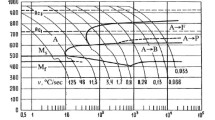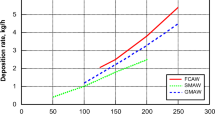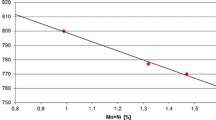Abstract
The mathematical model of the stress–strain state during flux-cored wire rolling in round gauges has been developed. Simulation was based on dividing the deformation zone into elementary volumes and simultaneous solution of the plasticity condition for porous materials and power static equilibrium equation inside the elementary volume. A distinctive feature of this model is taking into account the porous medium strain in the deformation zone. The experiments have confirmed the validity of the mathematical model for predicting the powder density and the energy-power characteristics of the process. Based on the developed mathematical model, the criteria and conditions for optimization were formulated, and the algorithm was developed for the automated design of technology for flux-cored wire rolling in round gauges. As an example of the obtained solutions implementation, the calculation of sintered copper flux-cored wire rolling technology was given.







Similar content being viewed by others
Abbreviations
- L pl :
-
Seal zone content
- L lag :
-
Backward slip zone content
- L adv :
-
Forward slip zone content
- ab, cd :
-
Boundary sections of deformation zone
- p x :
-
Standard surface stresses
- d x :
-
Composition thickness along the deformation zone length
- K R :
-
Number of elementary volumes when the deformation zone is broken along the rolling axis
- f x :
-
Coefficient of external friction
- L 0 :
-
Billet length before rolling
- L 1 :
-
Billet length after rolling
- S l1 :
-
Relative length of the forward slip zone on the driving working roll
- σ x :
-
Standard axial stresses
- α x :
-
Contact angle
- τ x :
-
Shear contact stresses
- \({\varepsilon }_{dx},{\varepsilon }_{lx}\) :
-
Deformation degree
- \({\gamma }_{x}\) :
-
Density ratio
- σ sxi :
-
Solid phase yield strength
- ε ex :
-
Equivalent strain
- ∆ε exj :
-
Equivalent strain increment
- σ 1 :
-
Front tension stress
- i :
-
Serial number of axial rolling section
- x :
-
Coordinate along the rolling axis
References
Srikarun B, Oo HZ, Petchsang S, Muangjunburee P (2019) The effects of dilution and choice of added powder on hardfacing deposited by submerged arc welding. Wear 424–425:246–254. https://doi.org/10.1016/j.wear.2019.02.027
Tušek J, Suban M (2003) High-productivity multiple-wire submerged-arc welding and cladding with metal-powder addition. J Mater Process Technol 133(1–2):207–213. https://doi.org/10.1016/S0924-0136(02)00235-2
Brass W, Scholz R (2015) U.S. Patent No. 9,162,305. Washington, DC: U.S. Patent and Trademark Office
Hoefer K, Haelsig A, Mayr P (2018) Arc-based additive manufacturing of steel components—Comparison of wire-and powder-based variants. Weld World 62(2):243–247. https://doi.org/10.1007/s40194-017-0527-9
Brandl E, Baufeld B, Leyens C, Gault R (2010) Additive manufactured Ti-6Al-4V using welding wire: comparison of laser and arc beam deposition and evaluation with respect to aerospace material specifications. Phys Procedia 5:595–606. https://doi.org/10.1016/j.phpro.2010.08.087
Zahiri R, Sundaramoorthy R, Lysz P, Subramanian C (2014) Hardfacing using ferro-alloy powder mixtures by submerged arc welding. Surf Coat Technol 260:220–229. https://doi.org/10.1016/j.surfcoat.2014.08.076
Ma Y, Gao Z, Qi Y, Zhang X, Wang L, Zhang Z, Wang D (2009) Fabrication and characterization of iron pnictide wires and bulk materials through the powder-in-tube method. Physica C 469(9–12):651–656. https://doi.org/10.1016/j.physc.2009.03.024
Ma Y, Wang L, Qi Y, Gao Z, Wang D, Zhang X (2010) Development of powder-in-tube processed iron pnictide wires and tapes. IEEE Trans Appl Supercond 21(3):2878–2881. https://doi.org/10.1109/TASC.2010.2079311
Wang Y, Zhang YQ, Wang B, Wang ZJ (2013) Study on Metal Transfer and Welding Spatter Characteristics of Basic Flux Cored Wire. Appl Mech Mater 477–478:1369–1372. https://doi.org/10.4028/www.scientific.net/AMM.477-478.1369
Liu HY, Li ZX, Li H, Shi YW (2008) Study on metal transfer modes and welding spatter characteristics of self-shielded flux cored wire. Sci Technol Weld Joining 13(8):777–780. https://doi.org/10.1179/174329308X380354
Das S, Talukdar S, Kumar A, Mukhopadhyay G (2020) Metallurgical investigation of welding wire rod grade during processing. Eng Fail Anal 118:1–9. https://doi.org/10.1016/j.engfailanal.2020.104884
Teoh LL (1995) Thermo-mechanical processing and microstructure of microalloyed steel bar and wire rod products. J Mater Process Technol 48(1–4):475–481. https://doi.org/10.1016/0924-0136(94)01685-T
Fattahi M, Rostami M, Amirkhanlu F, Arabian N, Ahmadi E, Moayedi H (2019) Fabrication of aluminum TIG welding filler rods reinforced by ZrO2/reduced graphene oxide hybrid nanoparticles via accumulative roll bonding. Diam Relat Mater 99:1–8. https://doi.org/10.1016/j.diamond.2019.107518
Bhattacharya R, Jha G, Kundu S, Shankar R, Gope N (2006) Influence of cooling rate on the structure and formation of oxide scale in low carbon steel wire rods during hot rolling. Surf Coat Technol 201(3–4):526–532. https://doi.org/10.1016/j.surfcoat.2005.12.014
Gehling T, Treutler K, Wesling V (2019) Targeted influence on the weld strength of high-strength fine-grain structural steels in the GMA welding process through functionalized weld material surfaces. Weld World 63(3):783–792. https://doi.org/10.1007/s40194-019-00707-2
Es-Saheb MH, Albedah A, Benyahia F (2011) Diametral compression test: validation using finite element analysis. Int J Adv Manuf Technol 57(5–8):501–509. https://doi.org/10.1007/s00170-011-3328-0
Hrairi M, Chtourou H, Gakwaya A, Guillot M (2011) Modeling the powder compaction process using the finite element method and inverse optimization. Int J Adv Manuf Technol 56(5–8):631–647. https://doi.org/10.1007/s00170-011-3211-z
Keshavarz S, Khoei AR, Molaeinia Z (2013) Genetic algorithm based numerical optimization of powder compaction process with temperature-dependent cap plasticity model. Int J Adv Manuf Technol 64(5–8):1057–1072. https://doi.org/10.1007/s00170-012-4053-z
Tseng HC, Hung C, Huang CC (2010) An analysis of the formability of aluminum/copper clad metals with different thicknesses by the finite element method and experiment. Int J Adv Manuf Technol 48(9–12):1029–1036. https://doi.org/10.1007/s00170-009-2446-4
Wang X, Hua L, Han X, Wang X, Wang D, Liu Y (2014) Numerical simulation and experimental study on geometry variations and process control method of vertical hot ring rolling. Int J Adv Manuf Technol 73(1–4):389–398. https://doi.org/10.1007/s00170-014-5770-2
Chekmarev AP, Klimenko PA, Vinogradov GA (1963) Investigation of specific pressure, specific friction, and the coefficient of friction during metal powder rolling. Sov Powder Metall+ 2(2):112–115. https://doi.org/10.1007/BF01111823
Volkogon GM, Dmitriev AM, Dobryakov EP (1991) Advanced technological processes stamping parts from powders and equipment. Mech Eng 320 (in Russian)
Katashinskii VP, Shtern MB (1983) Stress-strain state of powder being rolled in the densification zone. I. Mathematical model of rolling in the densification zone. Powder Metall Met Ceram 22(11):882–885. https://doi.org/10.1007/BF00805540
Katashinskii VP, Shtern MB (1983) Stress-strain state of powder being rolled in the densification zone. Powder Metall Met Ceram 22(12):972–976. https://doi.org/10.1007/BF00802421
Stepanenko AV, Isaevich LA, Kharlan VE (1990) Geometric and power parameters of the metal powder rolling process. I. Boundaries of the seat of deformation and stress field in the lag and forward slip zones. Powder Metall Met Ceram 29(2):101–105. https://doi.org/10.1007/BF00794530
Stepanenko AV, Isaevich LA, Kharlan VE (1991) Geometric and energy-force parameters of the process of rolling of metal powders II. The rolling power, moment, and contact stresses and distribution of density in the area of deformation. Powder Metall Met Ceram 30(2):101–105. https://doi.org/10.1007/BF00797280
Wang PT, Karabin ME (1994) Evolution of porosity during thin plate rolling of powder-based porous aluminum. Powder Technol 78(1):67–76. https://doi.org/10.1016/0032-5910(93)02768-6
Gogaev KA, Kalutskii GYa, Voropaev VS (2013) Contact stresses in the deformation zone and average pressure during asymmetric rolling of metal powders. Powder Metall Met C+ 52(3–4):126–131. https://doi.org/10.1007/s11106-013-9504-z
Chigarev VV, Belik AG, Gribkov EP, Gavrish PA (2015) A mathematical model of the process of rolling flux-cored tapes. Weld Int 26(9):718–722. https://doi.org/10.1080/09507116.2014.888192
Chigarev VV, Gavrish PA, Gribkov EP (2012) Investigation of the process of drawing flux-cored wire for welding copper to steel. Weld Int 29(1):70–74. https://doi.org/10.1080/09507116.2011.653152
Chigarev VV, Gavrish PA, Gribkov EP (2014) Improving the technological conditions of drawing flux-cored welding wires. Weld Int 28(1):59–61. https://doi.org/10.1080/09507116.2013.796655
Potapkin VF, Levkin AN, Satonin AV, Romanov SM, Vorob’yev YA, Gribkov EP (2000) Stress state and kinematics for rolling of powered materials on metal substrate. Powder Metall Met C+ 39(1–2):11–17. https://doi.org/10.1007/BF02677434
Gribkov EP, Perig AV, Danilyuk VA (2015) Research into the process of producing powder tapes. Int J Adv Manuf Technol 77(95–8):1087–1104. https://doi.org/10.1007/s00170-014-6496-x
Gribkov EP, Perig AV (2016) Research into the process of producing powder tapes. Int J Adv Manuf Technol 85:2887–2900. https://doi.org/10.1007/s00170-016-8714-1
Gribkov EP, Berezshnaya EV, Hurkovskaya SS, Malyhina SV (2018) Study into the rolling of a double-layered powdered core in a metallic sheath. East Eur J Enterp Technol 6:71–79. https://doi.org/10.15587/1729-4061.2018.150081
Hrudkina N, Aliieva L, Markov O, Marchenko I, Shapoval A, Abhari P, Kordenko M (2020) Predicting the shape formation of hollow parts with a flange in the process of combined radial-reverse extrusion. East Eur J Enterp Technol 4(106):55–62. https://doi.org/10.15587/1729-4061.2020.203988
Menezes PL, Kumar K, Kishore, et al (2009) Influence of friction during forming processes—a study using a numerical simulation technique. Int J Adv Manuf Technol 40:1067–1076. https://doi.org/10.1007/s00170-008-1425-5
Mori K, Osakada K (1987) Analysis of the forming process of sintered powder metals by rigid-plastic finite-element method. Int J Mech Sci 29(4):229–238. https://doi.org/10.1016/0020-7403(87)90037-3
Zheng ZX, Xia W, Zhou ZY (2013) Experimental and numerical modeling for powder rolling. Rev Adv Mater Sci 33:330–336. https://doi.org/10.4028/www.scientific.net/AMM.159.115
Lambiase F, Di Ilio A (2012) Deformation inhomogeneity in roll drawing process. J Manuf Process 14:208–215. https://doi.org/10.1016/j.jmapro.2011.12.005
Lambiase F, Di Ilio A (2012) Experimental and Finite Element Investigation of Roll Drawing Process. J Mater Eng Perform 21(2):161–166. https://doi.org/10.1007/s11665-011-9932-1
El AK, Larsson J, Pejryd L (2018) Experimental comparison of roller die and conventional wire drawing. J Mater Process Technol 257:7–14. https://doi.org/10.1016/j.jmatprotec.2018.02.012
Kim JH, Ko DC, Kim BM (2019) New tandem drawing process through non-driven four roll-die and converging die. J Mater Process Technol 263:470–478. https://doi.org/10.1016/j.jmatprotec.2018.08.016
Hwang JK (2020) Deformation Behaviors of Flat Rolled Wire in Twinning-Induced Plasticity Steel. Met Mater Int 26:603–616. https://doi.org/10.1007/s12540-019-00363-7
Polyakova M, Gulin A, Golubchik E (2018) Assessment of Structure Integrity and Mechanical Properties of Carbon Steel Wire in Combined Deformation Processing. Key Eng Mater 769:277–283. https://doi.org/10.4028/www.scientific.net/KEM.769.277
Poluhin PI et al (1982) Rolling production. Metallurgy, Moscow (in Russian)
Author information
Authors and Affiliations
Contributions
All authors participated in the design of this work and performed equally. All authors read and approved the final manuscript.
Corresponding author
Ethics declarations
Conflict of interest
The authors declare that they have no competing interests.
Disclosure
The submission of the authors’ paper implies that it has not been previously published, that it is not under consideration for publication elsewhere, and that it will not be published elsewhere in the same form without the written permission of the editors.
Additional information
Publisher's Note
Springer Nature remains neutral with regard to jurisdictional claims in published maps and institutional affiliations.
Rights and permissions
About this article
Cite this article
Gribkov, E.P., Malyhin, S.O., Hurkovskaya, S.S. et al. Mathematical modelling, study and computer-aided design of flux-cored wire rolling in round gauges. Int J Adv Manuf Technol 119, 4249–4263 (2022). https://doi.org/10.1007/s00170-022-08662-x
Received:
Accepted:
Published:
Issue Date:
DOI: https://doi.org/10.1007/s00170-022-08662-x




